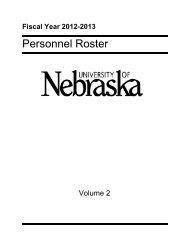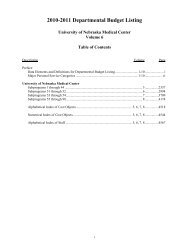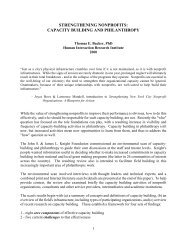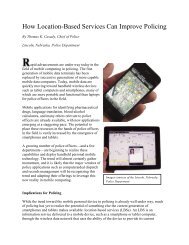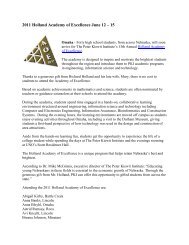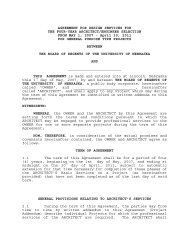University of Nebraska Board of Regents Board of Regents Meeting ...
University of Nebraska Board of Regents Board of Regents Meeting ...
University of Nebraska Board of Regents Board of Regents Meeting ...
Create successful ePaper yourself
Turn your PDF publications into a flip-book with our unique Google optimized e-Paper software.
laboratory spaces (575 square feet each). In addition, a sole-use controlled temperature and<br />
timed light room for large caged Drosophila studies (115 square feet) will exist. There will<br />
be a shared insectory for insect incubators (115 square feet), a shared tissue culture room<br />
(total <strong>of</strong> 115 square feet), a dedicated PCR/qPCR room (115 square feet), a microscopy suite<br />
(115 square feet), an animal facility (1200 sq ft), two equipment rooms with shared<br />
equipment (560 sq ft), and a prep area with autoclaves (590 sq ft). For classroom laboratory<br />
space, there is a dedicated Genetics/Molecular Biology teaching laboratory (1,100 sq ft), a<br />
Cellular Biology/biochemistry laboratory (1, 300 sq ft), and the Microbiology teaching<br />
laboratory (1,100 sq ft). For lecture space, there is a new building being constructed that will<br />
house 5 new classrooms (900 sq ft each), all <strong>of</strong> which will be smart classrooms. All <strong>of</strong> the<br />
rooms mentioned will be either new construction or newly renovated. The environment is<br />
conducive to teaching and to support undergraduate students eager to contribute to research<br />
efforts as part <strong>of</strong> their independent research project.<br />
Instructional equipment and informational resources<br />
No additional instructional equipment and informational resources are required.<br />
Instrumentation and equipment purchased by The Department <strong>of</strong> Biology, CNSS, and the<br />
BRIN-INBRE program is available to all researchers. These items include an ABI 7500 Real<br />
time PCR thermalcycler, an Eppendorf Nanodrop system, insect incubators, a Laminar flow<br />
hood, a CO2 tissue culture incubator, a fluorescent inverted microscope with DIC optics and<br />
camera, two fluorescent upright microscopes, a microplate reader, an isolated tissue bath<br />
system, microisolator cage systems for rearing rodents, a plant incubator, multiple<br />
conventional thermalcyclers, and other conventional microbiological and molecular<br />
equipment.<br />
Budget Projections<br />
The program can be provided for with our current and anticipated future budgets. There<br />
should be no additional implementation costs associated with: staffing, equipment, or capital<br />
purchases. Everything is currently in place to advance this program. Much <strong>of</strong> the applicable<br />
infrastructure has been developed over years <strong>of</strong> successful development <strong>of</strong> our commitment<br />
to grant supported undergraduate research and long-term planning in faculty recruitment.<br />
4. Evidence <strong>of</strong> Need and Demand; Enrollment Projections<br />
Need for program—in the institution, the community, the region, the state, or the nation<br />
Over the last 5 years, there has been a steady growth in the number <strong>of</strong> Biology majors. Until<br />
the summer <strong>of</strong> 2005, students could declare a straight Biology major or Comprehensive<br />
Biology major with a General, Wildlife, Environmental, Molecular Biology, or<br />
Environmental Health Emphasis. As <strong>of</strong> the fall <strong>of</strong> 2005, the emphases <strong>of</strong> the comprehensive<br />
major were either eliminated or changed. The General and Wildlife emphasis remained, the<br />
Environmental Health Emphasis was reformatted into the current Health Sciences Emphasis,<br />
and the Environmental and Molecular Emphases inactivated per a suggestion during the<br />
Biology Department’s 5-year Academic Program Review (APR). We now regret<br />
inactivating the Molecular Emphasis and believe that it was a shortsighted, knee-jerk reaction<br />
to the 5-year APR. The enrollment trends for the Biology major and Biology comprehensive<br />
5




